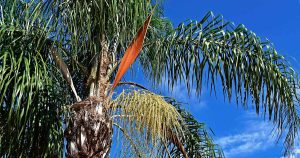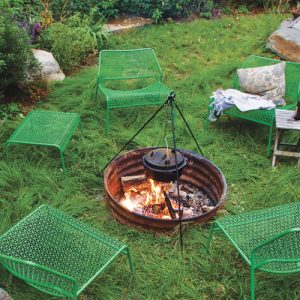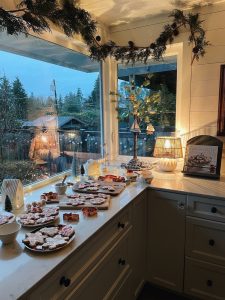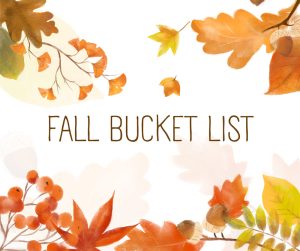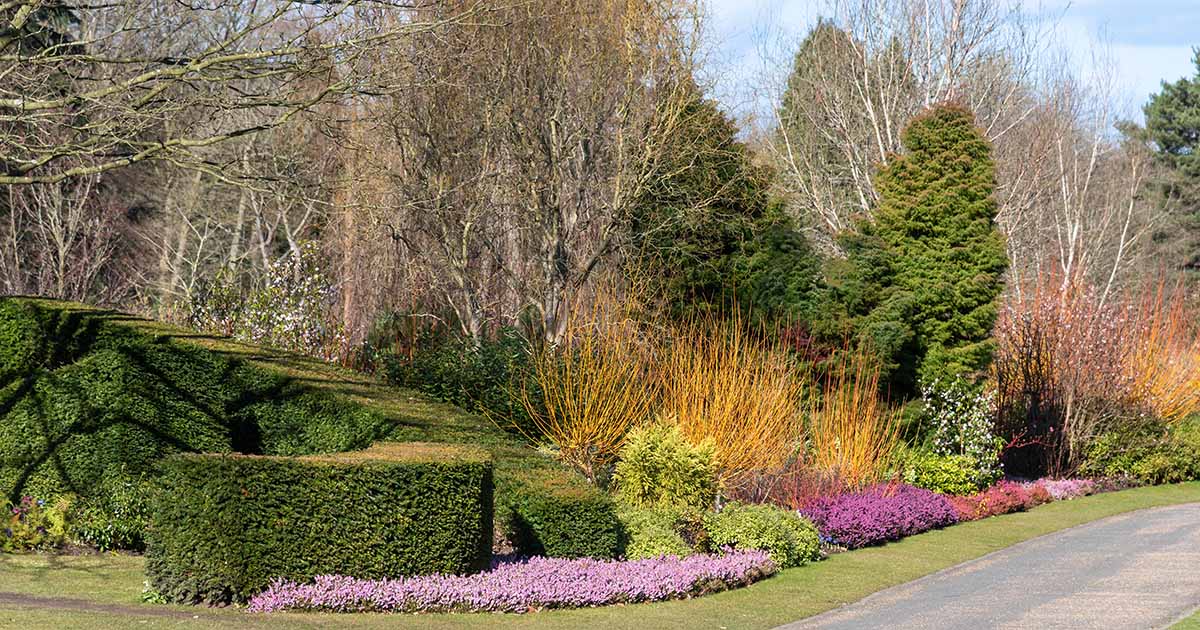
1. Bay Laurel
With a beautiful, dense canopy of glossy, dark green leaves, bay laurel (Laurus nobilis) is a garden shapeshifter that grows as a clumping shrub, but is easily pruned into hedges, pillars, topiary, or small trees with straight or spiraling trunks.
The fragrant evergreen foliage is a favorite kitchen seasoning and these handsome shrubs provide year-round visual interest plus privacy in areas with moderate winters.
They also make attractive scented additions to cold season decor like garlands, swags, and wreaths.
Hardy in USDA Zones 7 to 10, plants in one-gallon containers are available at Nature Hills Nursery.
Learn more about how to grow bay laurel in our guide.
2. Berry Box Pyracomeles
You’ll be berry pleased with the winter color of ‘Berry Box’ (x Pyracomeles) which produces stunning masses of bright orange to scarlet berries!

Flowering heavily in summer, the small white blooms transform into orange berries in fall, then turn deep scarlet in moderate cold season temperatures.
These handsome shrubs have a mature height of up to 42 inches with a spread of up to 36 inches and their mounding, compact habit is ideal for growing as barriers, in borders, foundations, planters, and rockeries. Hardy in Zones 7 to 9.
3. Boxwood
Boxwoods (Buxus spp.) are popular evergreen shrubs that can be trimmed and pruned into crisp borders, hedges, specimens, and topiary for containers and in formal, cottage, or contemporary gardens.
The multi-branched shrubs develop a lush, thick canopy of bright green, rounded leaves and many varieties take on bronzy hues in cold weather.
‘Winter Gem’ (B. microphylla var. japonica) has a mature height of 36 to 48 inches with a spread of 36 inches and is hardy in Zones 5 to 9.
Plants in three-gallon containers are available at Perfect Plants Nursery.
You can learn more about how to grow boxwood in our guide.
4. Camellia
As flowering evergreen trees or shrubs, camellias (Camellia spp.) are striking ornamentals that can be grown in containers, clusters, as privacy screens, or standalone specimens.
They feature large, showy single to double flowers of white, pink, or red.
For gorgeous, waxy blooms from late fall into early winter, cultivars of C. sasanqua are the best choice while C. japonica varieties bloom from midwinter to spring.
Most cold season varieties grow in the range of six to 12 feet tall with a similar width and are hardy in the moderate temperatures of Zones 7 to 9.
‘Yuletide’ is a C. sasanqua cultivar with large, single flowers of deep cerise with buttery yellow anthers. Plants are available in one- and three-gallon pots at Fast Growing Trees.
C. japonica ‘Debutante’ has semi-double deep pink flowers with lightly ruffled edges. Plants in one-gallon nursery pots are available at Perfect Plants Nursery.
Learn more about growing camellias in our comprehensive guide.
5. Cotoneaster
Cotoneaster (Cotoneaster spp.) species come in a large array of shapes and sizes, with glossy green leaves and long stems laden with clusters of burgundy, red, or orange berries in fall and winter.
And many varieties also have foliage that provides gorgeous fall and winter colors.
For a striking groundcover, cranberry cotoneaster (C. apiculatus) is festooned with masses of bright red berries and handsomely burnished foliage of burgundy, plum, and purple.
This compact shrub grows two to three feet tall with a spread of up to six feet and is hardy in Zones 4 to 7.
Shrubs in one- and three-gallon containers are available at Nature Hills Nursery.
Our guide to growing cotoneaster has more information.
6. Firethorn
An impressive semi-evergreen shrub, firethorn (Pyracantha coccinea) has shiny green leaves, small white flowers in spring, and abundant, showy clusters of orange to scarlet berries in fall that persist through winter.
The stiff, thorny branches make an excellent defensive barrier or hedge, can be sculpted into topiary, and is easily espaliered along fences, trellises, or walls.
Firethorn shrubs have a mature height and width of 10 to 15 feet and are hardy in Zones 5 to 9.
‘Red Cushion’ is a dwarf cultivar that stays low and compact and is available in nursery pots at Nature Hills Nursery.
7. Harry Lauder’s Walking Stick
Long-lasting and unique, the gnarled and contorted branches of Harry Lauder’s walking stick (Corylus avellana ‘Contorta’) provide excellent ornamental appeal.
Along with the beautiful, twisted stems, ‘Contorta’ also gives winter-busting charm with its large, golden yellow catkins that dangle from the branches late in the season.
An eye-catching specimen in containers, courtyards, and foundations or as a shrub border or hedge, plants are hardy in Zones 4 to 8.
Plants in three-gallon containers can be purchased at Nature Hills Nursery.
8. Heavenly Bamboo
An upright evergreen shrub, many cultivars of heavenly bamboo (Nandina domestica) feature new growth in bright scarlet or burgundy that transition to green for summer, and change again in fall to vibrant shades of crimson, plum, and purple that last until spring.
A reliable choice for containers as well as beds, borders, and hedges, Nandina isn’t a true bamboo, though it is considered invasive in some regions. You should check your local regulations before planting.
Plants grow up to seven feet tall with a five foot spread and are hardy in Zones 6 to 9.
Cultivars for impressive winter colors include ‘Burgundy Wine,’ ‘Firepower,’ and ‘Gulf Stream.’
‘Firepower’ features light green foliage that takes on a orangey-red hue in the summer months.
This cultivar is available in quart and gallon containers from Plants By Mail.
Learn more about heavenly bamboo in our growing guide.
9. Holly
The Ilex genus contains many holly species, including the prickly English or common variety (I. aquifolium) that are popular for winter holiday decorations, North American native species like the spineless, small-leaf yaupon (I. vomitoria) with pretty pink to red berries, and the Japanese varieties (I. crenata) that feature black berries and small oval leaves.
Holly makes a colorful addition to the landscape as specimen plants or barriers, hedges, and privacy screens, growing in a range of sizes and shapes, depending on the type.
Cold hardiness varies as well, from Zones 7 to 9 for English and yaupon types to Zones 5 to 9 for the Japanese ones.
‘Nellie Stevens’ (I. x ‘Nellie R. Stevens’) is a robust English hybrid with good disease resistance and produces bright red berries that remain in place throughout the winter.
Plants in one and three gallon containers are available at Perfect Plants Nursery.
Learn more about growing holly in our guide.
10. Juniper
Junipers (Juniperus spp.) are robust, low-maintenance evergreens native to the Northern Hemisphere with handsome gray, green, or glaucous foliage and masses of blue-green winter berries.
In some species, the foliage can also take on a cast of amber, bronze, or purple in cold temperatures.
Sizes range from a height and spread of one to 15 feet, depending on the variety, and these plants make attractive barriers, ground covers, hedges, and specimens. And the berries are a must-have for distilling gin!
Junipers are robust plants with good cold hardiness that are suitable for Zones 3 to 9.
‘Blue Rug’ is a compact, spreading ground cover that’s available in one, two, and three gallon pots at Perfect Plants Nursery.
Read our guide to growing juniper to learn more.
11. Kinnikinnick
Also known as bearberry, kinnikinnick (Arctostaphylos uva-ursi) is a widespread North American native.
It’s a low growing, evergreen shrub that features small and leathery, paddle-shaped leaves with charming, bell-shaped pink flowers in spring.
Used as a drought-tolerant ground cover, rockery plant, or cascading over a retaining wall, fall brings bright red berries and attractive burgundy, gold, and purple foliage that persists through winter along with papery, reddish bark.
These ground trailing shrubs grow only six to 12 inches tall but can spread as much as 15 feet. Very cold hardy and suitable for Zones 2 to 8.
‘Massachusetts’ has a spread of eight to 10 feet and is available in nursery containers at Nature Hills Nursery.
12. Leucothoe
A multi-stemmed, broadleaf evergreen with a pretty, arching growth habit, the Leucothoe genus has three North American species with sensational cold season interest.
As the weather cools, the thick leaves turn bronzy shades of burgundy, plum, and purple, adding elegant form and color to the cold season landscape.
Also called doghobble, these attractive shrubs feature luxurious panicles of creamy, bell-shaped flowers in spring and grow up to four feet tall and six feet wide. Hardy in Zones 5 to 8.
Burning Love™ (L. keiskei ‘Opstal 50’) is a dwarf variety with fantastic wine red and plumy purple winter foliage. Plants in one-gallon containers can be found at Nature Hills Nursery.
13. Ninebark
Common ninebark (Physocarpus opulifolius) is a flowering, deciduous shrub with four seasons of interest.
The descriptive name comes from its beautiful peeling bark in shades of light brown, cinnamon, tan, and gray.
Native to eastern North America, these hardy plants have a beautiful fountain-like shape and a profusion of pink tipped, creamy flowers in spring that develop into clusters of red fruit for summer.
In fall, the chartreuse-to-pea-green foliage turns bright yellow before dropping off to reveal the handsome branches of unique, exfoliating bark.
Ninebark grows five to eight feet tall with a spread of four to six feet and has excellent cold resistance that’s suitable for Zones 2 to 8.
Tiny Wine® (P. opulifolius ‘SMPOTW’) is an exquisite dwarf cultivar with bronzy burgundy foliage and is available at Nature Hills Nursery.
14. Oregon Grape
Oregon grape (Berberis syn. Mahonia spp.) is an ornamental evergreen shrub grown for its attractive foliage and three-season interest.
In late winter to early spring, pretty racemes of fragrant yellow flowers appear, giving way to clusters of attractive blue, purple, or black berries for fall and winter.
Depending on the variety, new foliage often emerges a burnished bronzy-red then deepens to dark forest green in summer.
In autumn, the leaves can take on fiery shades of orange, red, and yellow that adds impressive contrast to the dark berries.
Oregon grape makes for a unique specimen planting or addition to mixed shrub beds, and can be grouped into barriers and hedges.
Plants grow up to seven feet tall, spread up to 10 feet, and are hardy in Zones 5 to 9.
Oregon grape (B. aquifolium) can be purchased in large nursery containers at Nature Hills Nursery.
Check out our guide to growing Oregon grape to learn more.
15. Paperbush
Fragrant flowers late in the year can be hard to come by, but paperbush (Edgeworthia chrysantha) delivers an abundance of scented clusters with white and yellow or orange flowers in late winter to early spring.

By mid-December, the deciduous leaves have dropped away leaving an attractive multibranched silhouette with unique peeling bark – and plenty of flower buds that typically bloom in February, lasting for several weeks.
Paperbush makes an appealing specimen for containers and foundations or massed into borders and hedges.
These shrubs grow four to six feet tall and wide and are moderately hardy for growth in Zones 7 to 10.
16. Red Twig Dogwood
Red twig dogwood (Cornus sericea) is a highly desirable native plant that shines during the dormant period with multiple, fiery stems of coral, red, orange, or yellow.
The clumping shrubs with twiggy growth are superb against a snowy backdrop and for brightening gray days – they can be cut as well, adding a touch of drama to outdoor urns and holiday decorations.
Shrubs grow up to 15 feet tall with a similar spread and feature excellent cold hardiness for cultivation in Zones 2 to 8.
Arctic Fire (C. sericea ‘Farrow’) is a dwarf variety that grows three to five feet tall and wide with gorgeous, wine red twigs. It is available in three-gallon containers at Nature Hills Nursery.
The yellow twig cultivar, ‘Flaviramea,’ has brilliant yellow branches on shrubs that grow six to eight feet tall and wide.
It’s available in four-gallon pots at Nature Hills.
Learn more about growing red twig dogwood in our guide.
17. Snowberry
A tough and resilient native shrub, snowberry (Symphoricarpos albus) always delivers an interesting cold weather display with its clusters of attractive white to pink fruit.
Highly versatile and tolerant of a variety of conditions, late spring flowers are rosy pink, giving way to green drupes that mature to pure white by late summer and stay on the handsome, upright branches through winter.
An attractive addition to cut flower arrangements, foundations, mixed shrub beds, and cottage or naturalized gardens, shrubs grow two to five feet high and form thickets up to six feet wide.
Snowberry has excellent cold resistance and is hardy in Zones 2 to 7.
Plants in three-gallon containers are available at Nature Hills Nursery.
For a Symphoricarpos with colorful berries, ‘Sophie’ is a coralberry that features gorgeous drupes of fluorescent pink.
You can find ‘Sophie’ also available at Nature Hills.
Learn more about growing snowberry in our guide.
18. Winter Daphne
A small woody shrub, winter Daphne (Daphne odora) is excellent for cold weather interest with deliciously fragrant clusters of small pink flowers.
The rounded, compact shrubs are lightly branched with an open, airy shape, forming pink buds in midwinter and providing support for early pollinators.
The handsome foliage is evergreen, with some cultivars sporting variegated edging.
Place plants where the fragrance can be enjoyed, such as foundations, flanking entrances, or in containers.
These shrubs grow up to four feet high with a width of three feet and are hardy in Zones 6 to 10.
Marianni® (D. odora ‘Rogbret’) has lovely variegated leaves with pale yellow edging and is available in nursery pots at Nature Hills Nursery.
You can learn more about winter daphne in our growing guide.
19. Winter Jasmine
A trailing, semi-evergreen shrub with stiff, arching canes, winter jasmine (Jasminum nudiflorum) provides a beautiful burst of color late in the year with pretty, sunshine yellow flowers.

A reliable, low maintenance choice for bright color with a versatile structure, winter jasmine can be pruned into a barrier or hedge and is highly effective as a scrambling ground cover, spilling down banks or over retaining walls, or espaliered to a fence or wall.
Plants grow up to 15 feet tall and wide and are hardy in Zones 6 to 9.
Read our guide to growing winter jasmine to learn more.
20. Winterberry Holly
Cold hardy and heat tolerant, winterberry holly (Ilex verticillata) is a native plant with striking winter berries in coral, scarlet, or yellow that deserves its own mention.
As a deciduous shrub, once the leaves have fallen the handsome bare stems are laden with masses of gorgeous berries.
It’s the perfect foil for short, gray days as the shrub brightens borders, containers, foundations, hedges, and islands, either massed into groups or as a solo focal point.
Shrubs grow up to 15 feet tall and wide and there are several attractive dwarf varieties available.
You need to grow both a male and a female plant to produce berries. Winterberry has good cold resistance and is hardy in Zones 3 to 9.
Little Goblin Winterberry Holly
Little Goblin® (I. verticillata ‘NCIV2’) is a dwarf variety with coral orange berries and is available in three-gallon pots at Nature Hills Nursery.
21. Witch Hazel
A bushy, deciduous shrub, witch hazel (Hamamelis spp.) is a true winter-buster.
It produces dense clusters of long, graceful canes adorned with masses of fragrant and wonderfully shaggy yellow, red, or mauve flowers that bloom from late fall to early spring, depending on the type.
Witch hazel is a super accent or specimen plant and makes an impressive barrier or hedge when mass-planted in rows.
Sizes vary but run in the range of 12 to 20 feet high and wide and these shrubs are hardy in Zones 3 to 9.
Vernal witch hazel (H. vernalis) is a North American native that features pretty yellow to peachy red flowers with a light, spicy-sweet scent that grows up to 12 feet tall and wide.
Shrubs in three-gallon containers are available at Nature Hills Nursery.
Read more about how to grow witch hazel in our guide.
Glorious Gloom Busters
Shrubs that provide winter interest are ideal for brightening the garden, glorious gloom busters that take the sting out of winter’s short, dark days!

And even though most of these shrubs aren’t actively growing in cold weather, they offer a wide range of interesting features including textured bark, colorful berries, red-toned foliage, unique structural shapes, and even perfumed flowers.
Before purchasing, always ensure that your selection is suitable for your growing zone and provide your shrubs with optimal conditions for the best displays possible.
If you’re unsure, our growing guides have the lowdown on the cultivation needs for many of the above plants.
Then kick back and enjoy how they illuminate your winterscape!
Any suggestions to add to our list? What’s your favorite shrub for winter color? Tell us about it in the comments section below.
And for more information about growing woody shrubs, check out these guides next:




















